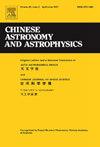Large-scale CO Multi-line Observations of the S187 HII Region
Q4 Physics and Astronomy
引用次数: 0
Abstract
The strong feedback of massive stars profoundly affects the interstellar medium around them, and may trigger the formation of next-generation stars. S187 is a massive star formation region located in the second quadrant of the Milky Way, showing a “Collect and Collapse” triggered star formation pattern. Based on the // (J=1-0, following J=1-0 is omitted for simplicity) spectra line data from the Milky Way Imaging Scroll Painting (MWISP) survey, the basic properties of the molecular cloud in the S187 region were studied, and the feedback of massive stars to molecular cloud was explored. Using GaussPy+ and clustering algorithm, 32 clouds were identified in this region, and the distances of eight of them were measured by combining the star extinction data of Gaia (Global Astrometric Interferometer for Astrophysics) satellite. The relatively dense gas content traced by and in S187 region is 1-2 orders of magnitude higher than that of molecular clouds in most regions of the second quadrant of the galactic plane. In the S187 region, 243 and 98 clumps were identified, among which 7 and 5 clumps had the potential to form massive stars. The results show that the feedback of massive stars has an obvious effect on the aggregation of molecular cloud around them, which provides conditions for the formation of the next-generation of massive stars.
S187 HII地区大尺度CO多线观测
大质量恒星的强烈反馈深刻地影响着它们周围的星际介质,并可能引发下一代恒星的形成。S187是一个位于银河系第二象限的大质量恒星形成区,呈现出“聚集和坍缩”触发的恒星形成模式。基于MWISP (Milky Way Imaging Scroll Painting)巡天12CO/13CO/C18O (J=1-0,下面省略J=1-0)谱线数据,研究了S187区域分子云的基本性质,并探讨了大质量恒星对分子云的反馈。利用GaussPy+和聚类算法在该区域识别出32个云,并结合Gaia (Global Astrometric Interferometer for Astrophysics)卫星的恒星消光数据测量了其中8个云的距离。S187区域13CO和C18O测得的相对致密气体含量比银道第二象限大部分区域的分子云高1-2个数量级。在S187区域,共鉴定出243个13CO和98个C18O团块,其中7个13CO和5个C18O团块具有形成大质量恒星的潜力。结果表明,大质量恒星的反馈对其周围分子云的聚集有明显的影响,为下一代大质量恒星的形成提供了条件。
本文章由计算机程序翻译,如有差异,请以英文原文为准。
求助全文
约1分钟内获得全文
求助全文
来源期刊

Chinese Astronomy and Astrophysics
Physics and Astronomy-Astronomy and Astrophysics
CiteScore
0.70
自引率
0.00%
发文量
20
期刊介绍:
The vigorous growth of astronomical and astrophysical science in China led to an increase in papers on astrophysics which Acta Astronomica Sinica could no longer absorb. Translations of papers from two new journals the Chinese Journal of Space Science and Acta Astrophysica Sinica are added to the translation of Acta Astronomica Sinica to form the new journal Chinese Astronomy and Astrophysics. Chinese Astronomy and Astrophysics brings English translations of notable articles to astronomers and astrophysicists outside China.
 求助内容:
求助内容: 应助结果提醒方式:
应助结果提醒方式:


